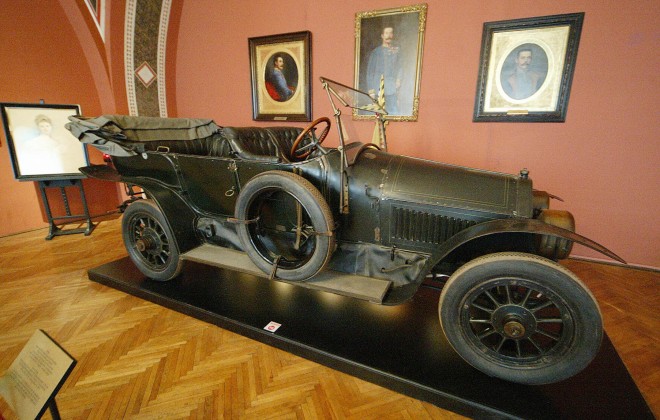
Most of us know that World War I started with the assassination of an Austrian Archduke in the Bosnian capital of Sarajevo. For the English-speaking world, however, the subsequent history of the conflict largely focuses on the Western Front, Gallipoli and other theatres where British, Commonwealth and American forces saw action. It is often forgotten that the war also raged across huge swathes of central and eastern Europe, involving almost all the nationalities that still live there today. Here are ten places in central and eastern Europe where memories of the Great War still loom large, especially as 2014 marks the WWI centenary.
The Museum of Sarajevo
Occupying a corner-house right beside the spot where the heir to the Austrian throne was gunned down, the Museum of Sarajevo displays pictures of the fateful events of June 28 1914, together with dummies of Franz-Ferdinand and his wife Sophie clad in representative (but not original) clothes. In a nod to present-day Bosnian-Herzegovinian politics, the ill-starred archducal pair are treated with sympathy here, and their assassin – the Bosnian-Serb revolutionary Gavrilo Princip – is portrayed as terrorist rather than freedom fighter.
The Military History Museum, Vienna
It’s in Vienna’s Heeresgeschichtliches Museum (Military History Museum) that you can admire the Gräf & Stift automobile in which Franz Ferdinand and spouse were shot; a lovely old motor that still preserves the scratches and holes left by grenades and bullets. The Archduke’s blue uniform is also on display, while his shirt – a much more macabre relic boasting bright red blood stains – will be put on show for a few weeks following the assassination centenary on June 28 2014.

Przemysl Fortress, Poland
Not so much a single fortress as a huge string of fortifications surrounding the southeastern Polish town of Przemyśl, Przemyśl Fortress was built by the Austrians in order to protect their domains against the neighbouring Russian Empire. It fell to the Russians following a long siege in 1915, but was recaptured by an Austrian-German offensive soon afterwards. It is now an emerging tourist attraction, with half-derelict former forts such as Salis Soglio, Borek and San Rideau providing an evocative look back at Austro-Hungarian military life.
The Historical and Maritime Museum, Pula
The Croatian city of Pula was Austria-Hungary’s largest naval base. Bottled up by Allied blockades for much of the war, the Austro-Hungarian dreadnoughts didn’t see much action. Pride-of-the-fleet battleship SMS Szent István didn’t sail in anger until June 1918, and was promptly sunk by a ten-man Italian torpedo boat. Pula’s Historical and Maritime Museum is a modest affair, but its evocative location in one of the city’s many Austrian sea forts is reason enough to visit.
Kobarid, Slovenia
Many of Austria-Hungary’s subject peoples were sent to defend the Empire against the Italians on the Isonzo Front, a mountainous borderland where troops had to carve defensive positions into icy peaks and inhospitable slopes. The soldiers of the Isonzo are commemorated in the Kobarid Museum in the Slovene town of Kobarid – a place immortalized under its Italian name of Caporetto in Hemingway’s novel A Farewell to Arms. One of the best war museums anywhere in Europe, the display covers the conflict with balance and empathy – the battles of the Isonzo were every bit as horrifying and wasteful as those of the Western Front.

Good Soldier Švejk in Prague
One of several characters who passed through Przemyśl Fortress was Good Soldier Švejk, the fictional creation of Czech novelist Jaroslav Hašek. Czech soldiers fought on all fronts during the 1914-18 war, and Czech capital Prague is planning several commemorative exhibitions in 2014. “In the Trenches of the Great War” at the Czech Army Museum will follow the fate of Czech conscripts in the Habsburg armies; while “Our Sea” at the Technical Museum will focus on the exploits (or rather lack thereof) of the Austro-Hungarian navy.
Military Museum, Sofia
Oh What a Lovely War? Not if you were Bulgarian. The Balkan nation entered the conflict in the hope of reversing the territorial losses incurred during the Balkan Wars of 1912-1913, only to end up on the losing side yet again. Sofia’s Military Museum is notable for recording with great pathos Bulgaria’s many defeats.
The Seaplane Harbour, Tallinn
Site of Tallinn’s spectacular new naval museum, the Seaplane Harbour is a cavernous and altogether rather beautiful concrete hangar built house a fleet of seaplanes by the Russians in World War I. A masterpiece of early twentieth century construction techniques, its multi-domed extent gives it the appearance of several cathedrals stitched together. There’s a lot of World War I-era materiel scattered around the display area, although the building itself remains the star.

Monument to the Victor, Belgrade
Serbia was blamed by Austria-Hungary for orchestrating the assassination of Franz Ferdinand, and went on to endure four years of war, occupation, disease and starvation. Something of a riposte to these enormous losses is the Monument to the Victor in Belgrade’s Kalemegdan Park, the work of Croatian sculptor Ivan Meštrović. Erected in 1928, the tenth anniversary of Serbia’s liberation from Austrian and Bulgarian troops, it continues to peer out across the Danube as if on the lookout for future challenges.
War Museum, Riga
Then part of the Russian Empire, Riga was a front-line city for much of World War I. The Tsarist authorities tried to harness Latvian patriotism by forming locally-recruited units known as the Latvian Riflemen in 1915. Sent to the front lines just outside the city, they incurred heavy losses. Eventually the Riflemen turned the tables on their masters, joining the Russian Revolution in 1917 and overthrowing the regime that had called them into being. The Latvian War Museum is the best place to catch up on their story.
Explore more of Europe with the Rough Guide to Europe. Book hostels for your trip, and don’t forget to purchase travel insurance before you go.
